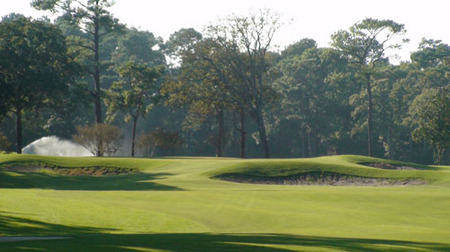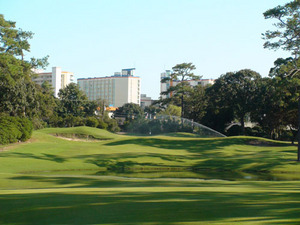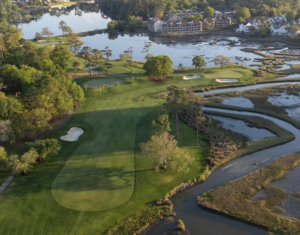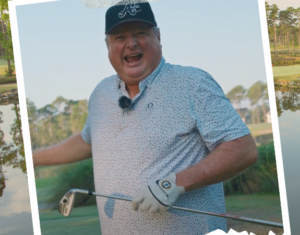First Look At The New Granddaddy
Plans for the renovation of Pine Lakes International Country Club began over four years ago. Craig Schreiner, the architect hired to restore the Granddaddy to its place among the Grand Strand’s elite, drew up 12 different layout scenarios over a period of 18 months.
Pine Lakes and its famed clubhouse are also part of the National Registry of Historic Places, adding another set of eyes the course’s renovation plans had to please.
The process has been long on details and devoid of corners cut, but arguably the most anticipated redesign in the history of Myrtle Beach golf is deep into the back nine, and if first impressions prove accurate, the hard work will payoff.
The renovations got underway in October of 2007 when Schreiner began a task that required him to spend 650 hours reshaping some of the most coveted real estate in Myrtle Beach. Pine Lakes won’t reopen until March 14, 2009, providing a surplus of time for the changes to take root, but the heavy lifting is largely complete.
Pine Lakes looks good enough to play today.
When golfers return to the layout next spring, the course will be substantially different than the one they remember, but paradoxically, it will be more similar to the one Robert White, the first president of the PGA, designed in 1927.
In preparing for the project, some of White’s original drawings were found in the Pine Lakes clubhouse, and they proved to be a treasure trove. The drawings included sketches of the greens and provided clues to course’s original routing (Pine Lakes began as a 27-hole facility called Ocean Forest before downsizing after the Great Depression and being renamed in 1944).
“We were able to expand a little more intelligently because of some of the old drawings we found,” said Schreiner, who worked with Nick Price to design the Grande Dunes member’s course. “They gave us the original square footage so we had a pretty good idea what Robert White put here (81) years ago.
“There is a lot of responsibility in trying to maintain the old character or identifying it and bring it back to life. It really wasn’t that hard here because we had nine holes fairly intact.”
The nine Schreiner is referring to will be holes 10 through 18 when the Pine Lakes reopens. The “new” back nine will mostly follow White’s original specifications from tee to green, but that doesn’t mean there won’t be changes.
There will much greater movement in the fairways as Schreiner raised the land’s natural highs and lowered its lows, a means of defense for a course that has fewer than 40 bunkers. Though he only designed two holes from scratch – No. 4 and No. 5 – the front nine required more creativity to emulate the feel of the course’s original holes, and Schreiner was up to the challenge. (click here for a hole by hole breakdown of the new (Pine Lakes)
Without prior knowledge, it would be virtually impossible to distinguish the “new” nine from the original as both sides feature five to seven feet of movement in the fairways, an element that will challenge players without overwhelming them.
“When you just look at the golf course, it looks relatively flat. It’s not,” Schreiner said. “(The holes) all have a rhythm that is very consistent with the original holes.”
In recent years the greens at Pine Lakes had become very small as the rest of the course encroached. One of the primary components of the redesign was the restoration of the greens to their original size. Though still not large, the greens at Pine Lakes will be almost twice as big upon its reopening at approximately 5,600 square feet each.
“The greens (will also) appear higher because we dropped everything around the greens,” Schreiner said. “We were able to drop the basins two to three feet and raise the greens approximately a foot.”
With undulating fairways and elevated greens, players will return to a 6,800-yard Granddaddy that has plenty of spunk.
“We have a par 70 with two really interesting par 5s, the strongest par 3s on the Strand, by far, and we added on the front and back two very long par 4s.” said Schreiner, who moved his offices to Myrtle Beach and lives on the course.
While the design changes will be obvious, Schreiner, working in conjunction with course owner Burroughs & Chapin, has also made Pine Lakes an environmentally friendly course, aided in part by mother nature.
Every bunker on the course will be filled with sand mined from the property. In particular, the large waste bunker on what is now No. 12 (a 417-yard, par 4) was mined for thousands of tons of sand that met USGA specifications. The sand that used to be on the course was recycled and is now being used top dress the course.
The oak trees, pine trees and crape myrtles that stood in the path of the redesign were replanted in an on-course nursery during construction and have since been returned to the course. Virtually nothing on the property was wasted and the maturity of the re-planted vegetation adds considerably to the layout’s visual appeal.
The fairway movement will enhance the challenge golfers face, and it will bring a more subtle benefit. As part of his work, Schreiner increased the amount of water on the course 10-fold and linked all of the property’s lakes via underground pipe. The course’s undulation will aid runoff and should provide Pine Lakes with the Grand Strand’s best irrigation system.
The course’s reopening will serve as a debut for Schreiner’s redesign and for pas palum’s entrance into the Grand Strand turf market. A warm weather grass that thrives in sodium heavy water (a critical factor for a course located less than ½ mile from the Ocean), pas palum can be cut to multiple heights.
As a result of the turf’s versatility, pas palum will be the only grass at Pine Lakes, covering everything from tee to green.
“It looks more like bentgrass than the Bermuda’s you see down here and that’s one of its appeals,” Schreiner said. “It’s got this lush green texture and you can grow it at several different heights.”
The course is still six months from opening, but it’s 98 percent grown in. The heavy design lifting is done, and Schreiner can’t wait for the public to get a new look at Myrtle Beach’s oldest course.
“It’s like taking the varnish off an old piece of furniture,” Schreiner said of his work. “If you paint something seven or eight times, all the detail gets lost. All you had to do was drop the lows and raise the highs, and the golf course just jumps out at you.
“I hope (golfers) love it, because I do.”
PINE LAKES PHOTO GALLERY










